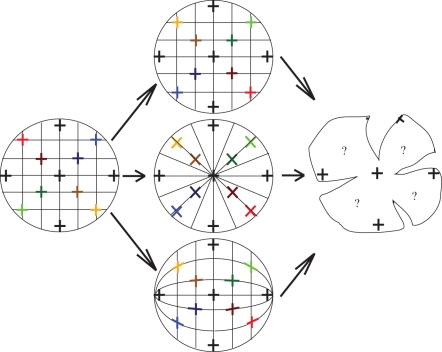Figure 1.
Three possible photoreceptor arrangements. The left picture represents a non-standard visual field that has been gridded with horizontal and vertical lines to represent horizontal and vertical e-vectors, the middle column shows three possible placements of individual orthogonal photoreceptors, (rhabdoms—the crosses) which correspond to the crosses in the visual field on the left viewed two-dimensionally (as if looking at a picture of a globe of the world), and the right column represents a single hypothetical wholemounted retina. Note that this projection is not to scale, but a simple representation of how horizontally and vertically oriented components in the visual field may translate onto the coleoid retina. The top row shows a simple square arrangement of photoreceptors, where the horizontal and vertical axes of the microvilli are aligned on horizontal and vertical axes across the retinal surface relative to the outside world. The middle row shows a radial arrangement of the photoreceptors, whose horizontal and vertical microvillar axes are arranged along lines that radiate out from the centre of the retina to the peripheral retina. The bottom row shows an arrangement of photoreceptors whose horizontal and vertical axes are aligned along lines of latitude and longitude rotated 90°.

